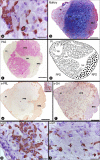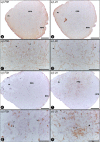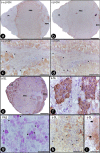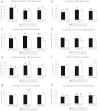Immunohistochemical study of pituitary cells in wild and captive Salminus hilarii (Characiformes: Characidae) females during the annual reproductive cycle
- PMID: 24083107
- PMCID: PMC3786080
- DOI: 10.1186/2193-1801-2-460
Immunohistochemical study of pituitary cells in wild and captive Salminus hilarii (Characiformes: Characidae) females during the annual reproductive cycle
Abstract
Freshwater fish that live exclusively in rivers are at particular risk from fragmentation of the aquatic system, mainly the species that migrate upriver for reproduction. That is the case of Salminus hilarii, an important migratory species currently classified as "almost threatened" in the São Paulo State (Brazil), facing water pollution, dam construction, riparian habitat destruction and environmental changes that are even more serious in this State. Additionally, this species show ovulation dysfunction in captivity. Our studies focused on the identification and distribution of the pituitary cell types in the adenohypophysis of S. hilarii females, including a morphometric analysis that compares pituitary cells from wild and captive broodstocks during the reproductive annual cycle. The morphology of adenohypophysial cells showed differences following the reproductive cycle and the environment. In general, optical density suggested a higher cellular activity during the previtellogenic (growth hormone) and vitellogenic (somatolactin) stages in both environments. Additionally, the nucleus/cell ratio analysis suggested that growth hormone and somatolactin cells were larger in wild than in captive females in most reproductive stages of the annual cycle. In contrast, prolactin hormone showed no variation throughout the reproductive cycle (in both environments). Morphometrical analyses related to reproduction of S. hilarii in different environmental conditions, suggest that somatolactin and growth hormone play an important role in reproduction in teleost and can be responsible for the regulation of associated processes that indirectly affect reproductive status.
Keywords: Gonadotropins; Growth hormone; Prolactin hormone; Reproductive dysfunction; Somatolactin hormone.
Figures





References
-
- Agostinho AA, Gomes LC, Suzuki HI, Júlio HF., Jr . Upper Paraná river basin Brazil. In: Carolsfeld J, Harvey B, Ross C, Baer A, editors. Migratory fishes of south America: biology, fisheries and conservation status. Victoria: World Fisheries Trust, The World Bank and the International Development Research Centre; 2003. pp. 19–98.
-
- Amaral JS, Melo RG, Honji RM, Moreira RG. Effects of migration impediment of Salminus hilarii (teleost: Characidae) on the pituitary-gonad axis. Comp Biochem Physiol A. 2007;148S:44.
-
- Andrade DR, Godinho AL, Godinho HP, Shimoda E. Biologia reprodutiva da tabarana, Salminus hilarii (Osteichthyes, Characidae) na represa de Três Marias, MG. Rev Bras Med Vet. 2006;28(1):26–32.
-
- Araújo BC, Mello PH, Honji RM, Moreira RG. The influence of captive breeding on the fatty acid profiles of Salminus hilarii (Characiformes: Characidae) eggs and larvae. Aquac Int. 2012;20:1161–1181. doi: 10.1007/s10499-011-9472-6. - DOI
LinkOut - more resources
Full Text Sources
Other Literature Sources

